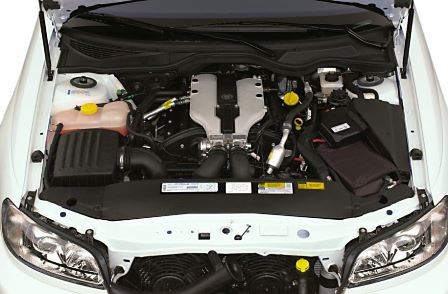The Cadillac Catera. Just the name itself might evoke a mixed bag of reactions from car enthusiasts. Some might recall the intriguing “Caddy that zigs” marketing campaign, while others might shudder at the memory of reliability nightmares. Parked in a forgotten corner of automotive history, or perhaps still occasionally sputtering down the road, the Catera begs the question: how did this German-engineered Cadillac even happen, and why are any still around?
Initially launched with promising sales figures in 1997 and 1998, hovering around 25,000 units annually, word of mouth and real-world experiences quickly took their toll. By 1999 and 2000, sales dwindled to approximately 15,000, plummeting further to under 10,000 in its final year, 2001. Many Cateras met an early demise due to significant reliability issues and the associated high costs of repair, infamous for timing belt failures that could catastrophically damage the engine.
For those that managed to survive the initial wave of mechanical maladies, the infamous “Cash for Clunkers” program likely claimed many more, thanks in part to the Catera’s less-than-stellar fuel economy. Considering its reputation and inherent issues, the continued existence of any Cadillac Cateras on the road today is somewhat surprising. Even personal accounts from owners who benefited from extended warranties often paint a picture of relentless, costly repairs. So, to truly understand the Catera, we need to delve into its origins and Cadillac’s ambitions at the time.
From Opel Omega to American Dream: The Catera’s European Roots
Before becoming the Cadillac Catera, its story began across the Atlantic with the Opel Omega, also known as the Vauxhall Carlton in some markets. Introduced in 1986, the Omega was a well-regarded German sedan positioned to compete with the likes of the Mercedes-Benz C-Class and E-Class, and the BMW 3 Series and 5 Series. It aimed to offer a compelling blend of German engineering at a competitive price point, providing interior space comparable to larger luxury sedans while being configurable from basic trims to near-luxury specifications.
The Opel Omega adopted a traditional front-engine, rear-wheel-drive layout, a somewhat contrarian approach as the automotive industry increasingly shifted towards front-wheel-drive configurations for efficiency and packaging. Its merits were recognized when it was awarded the European Car of the Year title in 1987. Notably, a high-performance variant, the Lotus Carlton (or Lotus Omega), emerged in 1989. Developed by Lotus, this version boasted twin turbochargers and an enlarged 3.6-liter engine, achieving a staggering top speed of 186 mph, showcasing the platform’s inherent potential.
When it made its way to American shores as the Cadillac Catera, it retained a 3.0-liter V6 engine, shared with some Saab and Saturn models. It was generously equipped, often featuring leather upholstery, a CD/cassette player with a Bose audio system, full power accessories, steering wheel audio controls, and a sunroof. Options like heated seats and a power sunshade were sometimes available, but the standard equipment list was already quite comprehensive for its class.
Cadillac’s Crossroads and the Allure of European Engineering
The Cadillac Catera arrived during a tumultuous period for General Motors and the Cadillac brand in particular. The 1980s had been a challenging decade, marked by missteps and a growing realization that the automotive landscape was shifting towards smaller, more agile, and often European-inspired vehicles. Cadillac’s previous attempts to address this shift, such as the infamous Cimarron – essentially a Chevrolet Cavalier with luxury trim – were widely criticized and failed to resonate with consumers. While Lincoln and Chrysler also attempted similar badge engineering exercises, Cadillac’s Cimarron became a lasting symbol of brand dilution and misjudgment.
Compounding these issues were Cadillac’s own engineering and quality control problems with initiatives like the 8-6-4 engine, diesel engine variants, and the HT4100 engine, alongside design quirks in downsized C-body and E-body platforms. These factors collectively alienated existing Cadillac customers, driving them towards Lincoln, Lexus, Acura, and European luxury brands. Faced with declining market share and an aging brand image, Cadillac recognized the urgent need for a product that could inject new life into its lineup and appeal to a younger, more discerning demographic.
The rationale behind importing the Opel Omega as the Catera was seemingly straightforward: leverage a proven European platform with minimal modifications to quickly offer a competitive product in the entry-luxury segment. The idea of importing European platforms to bolster domestic brands wasn’t new, but historically, it had a mixed record in the US market. While the 1970s Ford Capri achieved some success, attempts to sell European Fords, Opels (under Buick and Saturn), and the Ford Merkur experiment largely faltered. The prevailing theory suggests that buyers seeking a European car often prefer a European brand, while those wanting an American car stick with domestic marques.
By the mid-1990s, however, there were glimmers of hope for Cadillac. The introduction of the Northstar engine in 1993 was a significant leap forward, showcasing advanced technology like dual overhead camshafts, four valves per cylinder, and aluminum construction, delivering impressive power and refinement compared to Cadillac’s previous engine offerings. Furthermore, models like the Seville, Eldorado, and DeVille adopted sleeker, more contemporary styling, moving away from the boxy, chrome-laden designs of the past. While the niche Allanté project was ending, the need for a fresh, entry-level luxury sedan was paramount, leading Cadillac to import the Opel Omega and rebadge it as the Catera for the 1997 model year.
“The Caddy That Zigs”: Marketing Hype vs. Driving Reality
Cadillac’s marketing campaign for the Catera was arguably more memorable than the car itself. The “Caddy that zigs” slogan, accompanied by a cartoon duck and endorsements from figures like Cindy Crawford and “Dr. Lisa Catera,” aimed to project a youthful, dynamic image, a departure from Cadillac’s traditional association with older demographics. While the commercials, featuring Led Zeppelin music, were distinctive and gained attention, their effectiveness in translating into sustained sales success is debatable. The name “Catera” itself, while intended to sound sophisticated, lacked the resonance of Cadillac’s established nameplates and didn’t carry any inherent positive connotations.
In terms of the vehicle itself, the Cadillac Catera presented a mixed bag. Its build quality was undeniably solid, reflecting its German engineering roots. The doors closed with a reassuring “thunk” that was often absent in comparably priced Japanese and American sedans. The interior materials were generally perceived as upscale, offering a more luxurious feel than many competitors in its class, and even arguably nicer than its successor, the CTS, in some respects. The Catera provided ample interior space, comfortably accommodating four adults and reasonably seating five. Practical storage solutions were also well-integrated into the cabin.
However, the Catera’s styling was widely considered bland and generic, resembling other contemporary sedans like the Chevrolet Lumina or Hyundai Sonata. Its curb weight was substantial for its engine output, resulting in somewhat lackluster performance from its 200-horsepower V6. While marketed as a sportier Cadillac, the driving experience was generally described as unremarkable, lacking the agility and engagement expected from a true sport sedan. For the average driver, the Catera’s dynamic shortcomings might have been less noticeable, but for those seeking a genuinely sporty Cadillac, it fell short.
An Owner’s Tale of Woe: Reliability and Recurring Issues
Personal experiences from Cadillac Catera owners often highlight a consistent theme: reliability problems. One owner recounts their decision to purchase a new Catera in 2001, seeking a European-influenced, rear-wheel-drive sedan as a replacement for a problematic Oldsmobile Cutlass Supreme Convertible. Attracted by substantial incentives and the allure of German engineering, they opted for a new Catera, even investing in a GM extended warranty for peace of mind.
While manufacturer extended warranties can sometimes provide value, the owner’s experience with the Catera quickly became a test of its limits. Despite the warranty, the car was plagued by a seemingly endless series of issues. Faulty sunroof controls, body control module failures, air conditioning malfunctions, and persistent battery corrosion were just some of the recurring problems. The car required frequent visits to the dealership for repairs, with issues arising every few months, often coinciding with routine oil changes. The owner vividly recalls the escalating repair costs, with many individual fixes potentially exceeding $1,000, even on a relatively new vehicle. This experience fostered a lasting aversion to German automobiles for the owner.
Adding insult to injury, the Catera was involved in a collision just months after purchase. While stopped at a yellow light, the Catera was rear-ended by a Ford Aerostar, pushing it into an intersection and against a light pole, triggering airbag deployment and filling the cabin with smoke. Although the accident wasn’t the root cause of the car’s pre-existing mechanical issues, it further compounded the owner’s frustrations. Despite considering having the car totaled after the accident, they opted for repairs, unaware of the full extent of the Catera’s inherent problems.
As the odometer approached 80,000 miles and the extended warranty neared its expiration in 2006, the owner reached a breaking point. The combination of mediocre driving dynamics and relentless maintenance demands made continued ownership untenable.
The Catera’s Lasting Impact: More Zig Than Zag for Cadillac?
The Cadillac Catera’s overall impact on the Cadillac brand is debatable, but some argue it may have been more detrimental than even the much-maligned Cimarron. While the Cimarron was a flawed concept, it was arguably a reasonably well-executed compact car, fulfilling the niche of a “fancy Cavalier.” Cimarron owners may have been content with their purchase, and the model didn’t necessarily generate the same level of brand resentment. In contrast, the Catera failed to embody traditional Cadillac attributes of imposing presence, plushness, and abundant chrome. It came across as bland and uninspired in terms of styling, lacking the opulent grandeur expected of a Cadillac.
Furthermore, while marketed as a sportier, European-inspired Cadillac, the Catera didn’t deliver a truly engaging driving experience, yet it retained the higher maintenance costs often associated with European luxury cars. This mismatch between expectations and reality likely alienated potential Cadillac buyers. Unlike Cimarron customers who might have been seeking a smaller, more affordable Cadillac, Catera buyers were likely looking for a credible entry-luxury sedan, and many were likely disappointed and subsequently looked elsewhere.
In comparison, Lincoln’s LS, launched around the same time, achieved greater success. The LS offered more appealing styling, an available V8 engine, and a more refined driving experience, alongside a more overtly luxurious ambiance. The Lincoln LS achieved a respectable 262,900 sales over its seven-year run before being discontinued in 2006, partly due to Ford’s divestiture of Jaguar.
Seeking a more rewarding and reliable automotive experience after the Catera, the owner ultimately opted for a Buick Grand National, representing a return to a classic American performance icon. The Cadillac Catera, despite its European origins and “Caddy that zigs” aspirations, ultimately became a cautionary tale of brand missteps and unmet expectations in the competitive luxury car market.

